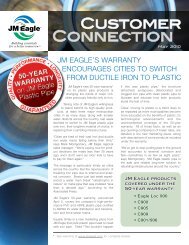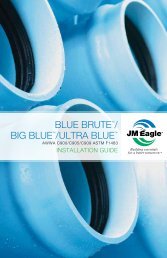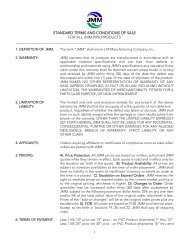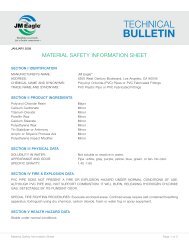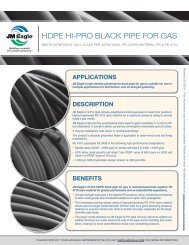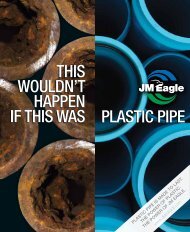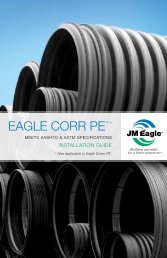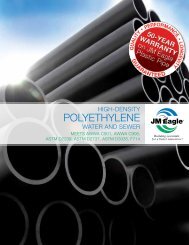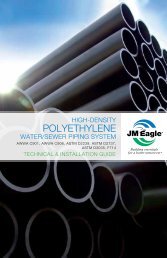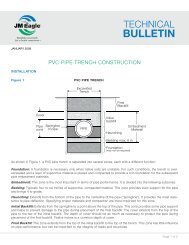INFRASTRUCTURE - JM Eagle
INFRASTRUCTURE - JM Eagle
INFRASTRUCTURE - JM Eagle
You also want an ePaper? Increase the reach of your titles
YUMPU automatically turns print PDFs into web optimized ePapers that Google loves.
UltraBluetmPVCOCrush resistantThe molecular orientation ofUltra Blue PVCO allows it to withstandextreme compression and be crushedflat without cracking, splitting or failing.
Editorial LetterCities Do Right bySwitching to Plastic Pipe“Can’t we do anything right anymore?” That was the cryof one MIT civil engineering professor recently, as quotedin The Boston Globe, in response to several spectacularinfrastructure failures in that city, including the break of a main thatbrings water to 2 million people. That metal water main was installedonly seven years ago.No city expects its water pipe or other public work to fail in lessthan a decade. Every city engineer, I am sure, has every intention ofbuilding an infrastructure to last. But how does one know that it will?Specifying plastic pipe from <strong>JM</strong> <strong>Eagle</strong> is one such way. At <strong>JM</strong> <strong>Eagle</strong>,we are so confident in the longevity of our high-quality plastic pipethat we recently announced a 50-year warranty on our AWWA-certifiedthermal-engineered products againstmanufacturing defects. It means that inthe rare event <strong>JM</strong> <strong>Eagle</strong> plastic water pipefails, we will pay to replace it and cover anydamage for the next 50 years.Since we announced the warrantyin April, it has turned the heads—andthe minds—of at least a dozen majormetropolitan cities throughout the UnitedStates. These are cities that have usedductile-, cast- or black-iron for decades.The specifying engineers recognize that thecitizens of their districts have put their trustin them, and they in turn are now placing their trust with <strong>JM</strong> <strong>Eagle</strong>.Yes, cities can do something right, and they are. They’re making theswitch to installing a reliable, sustainable and modern infrastructure thatonly <strong>JM</strong> <strong>Eagle</strong> plastic can deliver. Guaranteed..Sincerely,Walter WangPresident & CEO<strong>JM</strong> <strong>Eagle</strong>water<strong>INFRASTRUCTURE</strong>magazineEditorialElizabeth BrewsterEditorial DirectorSteve DwyerContributing EditorJeff BowesArt DirectorBusinessShannon BurnettMedia CoordinatorCindy CardinalCirculation<strong>JM</strong> <strong>Eagle</strong>Neal GordonVice President of MarketingSarah HumphreysMarketing Communications ManagerAndrew GenewickMarketing Communications CoordinatorWater <strong>INFRASTRUCTURE</strong> magazineis published by<strong>JM</strong> <strong>Eagle</strong>5200 West Century Blvd.Los Angeles, CA 90045(800) 621-4404www.jmeagle.comJ-M Manufacturing Co. Inc. and PW <strong>Eagle</strong> Inc.are doing business as <strong>JM</strong> <strong>Eagle</strong>. © 2010 by<strong>JM</strong> <strong>Eagle</strong>. All rights reserved. Reproduction of thewhole or any part of the contents without writtenpermission is prohibited. Printed in U.S.A.4 Water Infrastructure • Summer 2010 www.jmeagle.com
water<strong>INFRASTRUCTURE</strong>magazineSummer Issue 2010TABLE OF CONTENTSFeature Stories6 To the Test: Putting PlasticPipe through Its PacesHere’s a guide to the extensive testingprocess that stands behind the reliabilityof plastic pipe.10 Case Study: MassachusettsThanks to stimulus funds, a Massachusettstown is replacing its outmoded sewer systemwith plastic pipe supplied by <strong>JM</strong> <strong>Eagle</strong>.14 QA: Raising the Baron Quality Assurance<strong>JM</strong> <strong>Eagle</strong>’s plant in Adel, Ga., succeeds bymaking sure its plastic pipe holds up torigorous standards.617 Pipe Primer: PE PipeGoes with the FlowHarsh conditions, trenchless installation andnuclear power plants are just three of themany applications and environments wherePE pipe shines.101420 Case Study: Bringing Waterto the Navajo Nation<strong>JM</strong> <strong>Eagle</strong> helps make pipe dreams areality for Navajo communities living inNew Mexico.17www.jmeagle.com Summer 2010 • Water Infrastructure 5
To the Test: Plastic PipeTo the Test:Putting Plastic Pipethrough Its PacesA guide to the extensive testing processthat stands behind the reliability of plastic pipe.by Steve DwyerPVC and PE pipe systems last longer thancompeting pipe products not only becauseof their inherent quality, but also thanks tostringent testing at the plant level beforeplastic pipes are shipped out.Plastic-pipe manufacturer <strong>JM</strong> <strong>Eagle</strong>, for instance,knows its plant managers sleep well at night, safe in theknowledge that their internal testing requirements notonly meet but exceed mandates by third-party testers.What kinds of testing procedures do plastic-pipeproducts face before they can pass muster with a thirdparty? Here’s a guide to the national organizations that testplastic pipe, and their requirements for top-quality pipes.6 Water Infrastructure • Summer 2010 www.jmeagle.com
National SanitationFoundation InternationalAnn Arbor, Mich.www.nsf.orgPlastic piping certified by NSF International to NSF/ANSI Standard 14 (a performance and health effectssafety standard) has met a rigorous certificationprocess, including but not limited to:• A full formulation and engineering drawing review.• Initial and annual product testing (both forperformance and health effects safety).• Three annual unannounced facility audits ateach facility that manufactures the certified pipe.• Facility quality control requirements that specifyenvironmental, recordkeeping, stringent qualitycontrol testing and calibration procedures.NSF’s standard procedures require that auditorsreview and verify the product’s AuthorizedRegistered Formulation and collect random samplesfrom each facility during unannounced facilityaudits. The auditor stamps the sample with a uniqueidentifier to ensure chain of custody before it isshipped to NSF’s laboratories in Ann Arbor, whereannual tests are conducted.NSF does not allow a manufacturer to changethe NSF Authorized Registered Formulationwithout NSF’s prior approval. NSF will not permitcertification or re-certification of a product that failsto meet its rigorous requirements.Underwriters LaboratoriesCamas, Wash.www.ul.comUL has established construction requirementsthat affect materials, pipe joints, wall thickness,imperfections and sealing gaskets. They arereflected in UL’s 1285 Pipe and Couplings, PVC,and oriented PVCO for Underground Fire Service,which was updated with modified standards inJuly 2008.Consult UL or its website for full requirements,but here is a brief synopsis of each requirement:R Materials. PVC pipe and couplings need to bemade from Cell Class 12454 virgin compounds asdefined in the Standard Specification for rigid PVCcompounds and CPVC compounds. PVC pipe andcouplings must have an established hydrostaticdesign basis (HDB) rating of 4,000 psig (27.6 MPa)for water at 73.4 F.R Pipe joints. If a coupling is used to join the pipeends, then each length of pipe must have a couplingwith sealing ring gaskets; each coupling needs to bethe same composition, trade size and pressure classas the pipe. If a bell-and-spigot joint is used, theneach length of pipe must have a sealing gasket.R Wall thickness. For PVC pipe, the minimum wallthickness for each size and pressure class is specifiedin one of two standards. First is the standard forPVC pressure pipe and fabricated fittings, 4 inchesthrough 12 inches (100 mm through 300 mm), forwater transmission and distribution, ANSI/AWWAC900. Second is the standard for PVC pressure pipeand fabricated fittings, 14 inches through 48 inches(350 mm through 1,200 mm), for water transmissionand distribution, ANSI/AWWA C905.R Imperfections. Pipe must be homogenousthroughout with no voids, cracks, inclusionsor other defects that impair product’s intendedperformances. Axial dents, gouges, bruises, toolmarks or grooves in the gasket sealing area ofthe pipe section or coupling cannot be deeperthat 1/32 inch.R Sealing gaskets. A sealing gasket must be madeof a vulcanized natural rubber or a synthetic rubbercompound. It needs to have uniform dimensionsand sufficient thickness to provide a compressionlikeseal.UL also requires a series of performance tests.Representative samples of each pressure class andnominal size PVC pipe and couplings are subjectto the tests described in sections 12-20. (For moreinformation, see UL’s online Collaborative StandardsDevelopment System at www.csds.ul.com.)These performance tests assess short-termhydrostatic pressure, joint leakage, assembly,flattening, impact resistance, material tensile-strength,long-term hydrostatic pressure, and extrusion quality.For more specific details, consult www.csds.ul.com.Plastics Pipe InstituteIrving, Texaswww.plasticpipe.orgControlling the quality of the raw material used inproducing pipe is the first essential condition forwww.jmeagle.com Summer 2010 • Water Infrastructure 7
To the Test: Plastic Pipebe assigned identifying numbers, and permanentrecords should be kept.Control of pipe quality during the pipemanufacturing process is the next essential conditionfor compliance. A competent quality control programfor manufacturing includes: continuous inspection ofeach step using visual and/or automated inspectionprocedures; testing samples of the finished pipe; andselection at a predetermined frequency.In addition to records of these items, andto ensure traceability of the manufactured pipe,quality control reports must record the plant, dateand shift of manufacture, production line and resinlot designations. All conforming products mustbe identified with permanent markings indicatingthe manufacturer, manufacturing plant, date ofmanufacture, applicable specification designation andthe pipe’s nominal diameter.A well-designed QA/QC program includesperiodic audits of the program’s efficacy.Such audits generally address evaluation ofmanufactured pipe and fittings in inventory;inspection and recalibration (if necessary) of QCtesting equipment; QC inspection and reportingprocedures; raw material sampling, testing and lotcontrol procedures; product certification procedures;processing of customer complaints; correctiveactions; and processing of recommendations fromplant personnel.complying with the specified requirements of thefinished product. HDPE resins used to producecorrugated polyethylene pipe must be sampled,tested and approved for use to assure compliancewith AASHTO and ASTM cell classificationrequirements.A resin vendor’s certification characterizingthe material (e.g., virgin material) and statingcompliance with all requirements must accompanyall raw material resins used to manufacture pipe.The pipe manufacturer’s responsibility includestesting randomly selected samples from each lotfor verification of density (ASTM D 1505) and meltindex (ASTM D 1238), tensile strength (ASTM D638) and environmental stress crack resistance(ASTM D 1693, ASTM D 5397 or ASTM F 2136).For reference and manufacturing processcontrol purposes, accepted material lots shouldFM ApprovalsJohnston, R.I.www.fmglobal.comIn the standard design of PVC pipe, if amanufacturer’s literature or pipe markingsreference any recognized standard specifyingdesign, manufacture or performance, FM Approvalswill verify—as part of its examination—thatall referenced criteria are met. (FM 1612 is theunderlying product standard of an FM listing forPVC pipe for underground fire protection.) Therequirement’s intent is that PVC pipe and fittingsconform to the recognized standard to which theyare manufactured. Regarding test/verificationwithin the standard design, the manufacturer mustsubmit to FM Approvals a copy of the relevantstandards, along with drawings, specifications andother documents necessary to confirm compliance.8 Water Infrastructure • Summer 2010 www.jmeagle.com
FM Approvals will verify that all requirements ofthat standard are met.Requirements specifically measure: quick-burststrength, hydrostatic strength, stiffness, abuse,vacuum and one-hour pressure. A quick-burst testwill be conducted on all classes and sizes of pipesubmitted for approval. At least one sample ofeach class and size of pipe, including the integralbell, will be subjected to a 73-degree Fahrenheitquick-burst hydrostatic test. In this test, the internalpressure will be raised from zero to the minimumrequired pressure in not less than 60 and not morethan 70 seconds.FM Approvals’ requirement for stiffness is thatpipe must have sufficient stiffness to remain intactand not leak when exposed to external forces causedby earth and heavy vehicle loads.The abuse test requires that a 100 lb f -ft (135 N-m)impact will not impact the hydrostatic integrity of thepipe and fittings. The intent of this requirement is thatthe piping be resistant to minor impacts encounteredduring handling, installation and service.A vacuum test verifies the integrity of flexibleelastomeric seals—a component of the pipe joints--during a one-hour test. There should be no leakageas a result of this test. A test joint assembly shouldbe prepared using only the lubricant and procedurerecommended by the manufacturer.Additional tests may be required, dependingon the design features, results of tests or materialapplication, or to verify the integrity and reliabilityof the PVC pipe and fittings at FM Approvals’discretion. Unexplained failures will not bepermitted, and a re-test will be accepted only atthe discretion of FM Approvals and with adequatetechnical justification of the conditions and reasonsfor failure.ASTM InternationalWest Conshohocken, Penn.www.astm.orgASTM’s Proficiency Test Program sets standardsrequirements for both PVC and PE cellclassification. It provides participating laboratorieswith a statistical quality assurance tool, enablinglabs to compare, improve and maintain theirperformance in the use of ASTM methods againstother labs worldwide.Conducted biannually, this program provides(for each test cycle) four test samples, forms torecord test data, and instructions for conducting thetests. Laboratories are instructed to conduct the testsin their facilities using the ASTM methods cited inthe program and to record their test results on theelectronic data forms.Each laboratory submits completed test datato ASTM for use in generating statistical summaryreports. ASTM handles all data on a strictlyconfidential basis with no disclosure of lab identityexcept for one’s own laboratory. Final reportscontain all laboratory test data (coded), statisticalanalysis of test data, charts plotting test results vs.lab code and other information.The program includes lab participationworldwide, with more than 95 labs participating inthe 2009 program. Owww.jmeagle.com Summer 2010 • Water Infrastructure 9
Case Study: MassachusettsMade in America:RebuildingMassachusetts’ InfrastructureH H H H HThanks to stimulus funds, a Massachusetts town is replacing itsoutmoded sewer system with plastic pipe supplied by <strong>JM</strong> <strong>Eagle</strong>.by Elizabeth BrewsterFramingham, Mass., is ushering in a new eraof plastic pipe for the old iron sewer systemon its eastern boundaries. With its switchfrom iron to plastic for the East FraminghamSewer Improvement Project, the New England townjoins a growing number of cities throughout thecountry that are turning to plastic piping for theirsewer systems, even in the traditionally iron-friendlyNortheastern United States.The East Framingham project, which brokeground in April, is an estimated $40 million effortthat will reconfigure the sewer system through aportion of East Framingham, using approximately17,000 feet of <strong>JM</strong> <strong>Eagle</strong> Ring-Tite PVC sewer pipeand nearly 6,000 feet of 18- and 20-inch Big BlueC905 PVC pipe.H H H H HThe new sewer systemwill take advantage ofplastic pipe’s benefitsto boost efficiency.H H H H HThe new sewer system will take advantage ofplastic pipe’s benefits to boost efficiency and helpmeet the neighborhood’s future wastewater needs.More than 3 miles of existing force main arebeing decommissioned and several existing pumpstations will be eliminated, while a new wastewatermanagement facility will pump and convey up to 13million gallons per day of wastewater.“Right now we’re just getting going—the projectis 5 to 6 percent done,” says Gino Gioioso, an ownerand project superintendent for P. Gioioso & SonsInc., the Hyde Park, Mass.-based general contractorfor the project. “We’re concentrating on doing mostof the water work this year,” and workers werescheduled to start laying <strong>JM</strong> <strong>Eagle</strong> plastic pipe inearly July, he says. “We will be laying that plasticpipe into next year . . . and the [project] is scheduledto finish in the spring of 2012.”Stimulus fundingThe town of Framingham, located about 20 mileswest of Boston, had been working on improvingits aging sewer system since a major sewer linecollapse in 2000. Stimulus funding from the 2009American Recovery and Reinvestment Act helpedset their plans in motion. The stimulus grants of$4.46 million are being supplemented by low-interestloan proceeds from a Massachusetts revolving fundfor the rest of the funding. Because of the stimulusdollars, Framingham was required to purchasematerials manufactured in America—and that made<strong>JM</strong> <strong>Eagle</strong>’s plastic piping a perfect fit, says Gioioso.10 Water Infrastructure • Summer 2010 www.jmeagle.comwww.jmeagle.com Spring 2010 • Water Infrastructure 10
In addition, “with [the gravity sewer pipe], thekey thing is does it pass the air test,” says KevinMarston, marketing representative for Everett J.Prescott Inc., a <strong>JM</strong> <strong>Eagle</strong> distributor. “And [the <strong>JM</strong><strong>Eagle</strong>] pipe passes air tests.”There’s no tuberculation, and no costly lining,wrapping, coating or cathodic protection is needed.And of course, all <strong>JM</strong> <strong>Eagle</strong> pipe is tested andsubject to inspection by quality control inspectorsthroughout every step of the manufacturing process.Combating corrosionThe new sewer system, which will encompass about40 percent of the daily sewage flow in Framingham,will replace an outdated system that needed constantmaintenance and that has experienced multiplesanitary sewer overflows. In addition, industrialdischarge of sulfides corrosive to downstream pipinghas led to expensive pipeline failures. The inabilityof iron pipes to impedecorrosion as well as plasticpiping does made PVCpipes a natural choice forFramingham’s project.That’s why <strong>JM</strong> <strong>Eagle</strong>’scorrosion-resistant plasticpipes will be a welcomechange for the town. Ring-Tite PVC sewer pipe isunaffected by the fluidsfound in ordinary domesticsewage, and it is immuneto sewer gases and the sulfuric acidgenerated by the completion of thehydrogen sulfide cycle. The pipe is alsoimmune to corrosive soils, both alkalineand acidic.Big Blue PVC pipe is also unaffectedby electrolyte or galvanic corrosion, or anyknown corrosive soil or water conditions.Sewer pipe solutions<strong>JM</strong> <strong>Eagle</strong>’s Ring-Tite PVC sewer pipeand Big Blue C905 PVC pipe offer manybenefits for sewer systems, including:4 Long laying lengths4 Quality control testing and inspectionthroughout manufacturing4 Non-corroding4 Excellent abrasion resistance4 High carrying capacity4 Light weight for easy handlingSweet endingsCorrosion resistance is especially importantbecause the East Framingham Sewer ImprovementProject was designed to comply with a settlementagreement with the Massachusetts Water ResourcesAuthority and an administrative consent orderfrom the Massachusetts Department ofEnvironmental Protection to address odor andcorrosion impacts of the existing systemon the MWRA’s downstream sewersystem, in addition to getting rid ofsanitary sewer overflows.The town is also required by the stateDEP to finish the project by 2013.With the ease of installation for<strong>JM</strong> <strong>Eagle</strong>’s plastic pipes, that shouldbe no problem. The standard layinglength of Big Blue PVC andRing-Tite pipe is 20 feet(also 14 feet for Ring-Tite),which means workerscan cover more groundduring installation whileavoiding the cost ofunnecessary joints.The end result? Afaster path to a new sewersystem that will benefitFramingham residents formany years to come. ORendering of the new wastewater management facilitywww.jmeagle.com Summer 2010 • Water Infrastructure 11
Quality AssuranceRaising the Bar onQuality Assurance<strong>JM</strong> <strong>Eagle</strong>’s Adel, Ga., plant succeedsby putting plastic pipe through rigorous paces.When quality assurance testers comecalling—unannounced, as always—at<strong>JM</strong> <strong>Eagle</strong>’s Adel, Ga., production plant,manager Randy Sackewitz welcomesthem with open arms.That’s because Sackewitz already knows whatthe outcome of the visit will be: two thumbs up.For years, the Adel plant has demonstrated parexcellence in internal testing of its polyvinylchlorideand polyethylene pipe products.“Our own internal methods exceed those testingrequirements from outside organizations,” saysSackewitz, adding that organizations like NationalSanitation Foundation International and AmericanWater Works Association visit the Adel plantquarterly, while Underwriters Laboratories must paya visit 48 times a year.These organizations use the pipe specificationsestablished by ASTM International, which sets specsand classifications for plastic pipe but does notperform testing or audits at manufacturing facilities.“Take the acetone test,” says Sackewitz. “There’dbe a fusion requirement. We allow for what wecall ‘zero attack.’ That means the pipe must be100 percent fused or we’re not sending it out. Therequirements by one of the external testing bodies(however) might actually allow for some ‘attacking’of acetone on the plastic pipe.”The <strong>JM</strong> <strong>Eagle</strong> plant’s commitment to qualityassurance speaks volumes about its mission toensure that all is in order at the plant level, so thatFlattening test: Each specimen must be flattenedwithin two to five minutes.everything goes off without a hitch at the distributorand contractor level.“I have been involved in the manufacture andtesting of PVC pipe for the past 10 years,” saysSackewitz, who also has worked in the aerospaceindustry. “I have never before seen a company thatholds itself to a higher level of scrutiny in regards toquality of product and industry standards than <strong>JM</strong><strong>Eagle</strong>. When one compares the standards that governquality in our industry, <strong>JM</strong> <strong>Eagle</strong>’s in-house qualityspecifications are nearly always more stringent thanthose required by outside auditors. This leads to avery high comfort level that I have with plastic pipevs. any other material that pipe is made from.”The Adel advantageMaintaining that higher level of scrutiny in product14 Water Infrastructure • Summer 2010 www.jmeagle.com
Testing, Testing . . .Here are the quality assurance tests that make up the rigorous QA process at <strong>JM</strong> <strong>Eagle</strong>’s Adel, Ga.,plant, as well as all other <strong>JM</strong> <strong>Eagle</strong> plants.1. Acetone testing. The test is used for distinguishing between inadequately fused andadequately fused PVC. A 1-inch specimen stands immersed in acetone for 20 minutes, then isremoved and inspected for signs of attack. Attack is described as a lifting, raising or removingof any material on the outside surface, inside surface, or mid-wall of the specimen. Swelling orsoftening of the test specimen is not considered attack. (ASTM D2152)2. Flattening test. The specimen is placed between two parallel plates and thencompressed in a suitable press until the distance between the plates is 40 percent or less of theoriginal outside diameter. The rate of flattening must be uniform and such that each specimen isflattened within two to five minutes. The applied load is removed and each specimen examined.Evidence of splitting, cracking or breaking constitutes failure. (AWWA section 4.3.3.4)3. Impact test. The test covers determination of the impact resistance of thermoplastic pipe andfittings under specified conditions of impact by means of a tup (falling weight). Three interchangeablestriking noses are used on the tup, differing in geometrical configuration. (ASTM D2224)4. Short term burst. This covers determination of the resistance of either thermoplasticor reinforced thermosetting resin pipe, tubing or fittings to hydraulic pressure in a short timeperiod. The test method consists of loading a specimen to failure, or a predetermined minimumlevel, in a short time interval by means of continuously increasing internal hydraulic pressurewhile immersed in a controlled-temperature environment. The specimen must meet or exceed aminimum of 6,400 psi hoop stress within 60 to 70 seconds. (UL file #EX2823 / ASTM D1599)5. Sustained pressure. This covers determination of the time-to-failure of both thermoplasticand reinforced thermosetting/resin pipe under constant internal pressure. The test method consistsof exposing specimens of pipe to a constant internal pressure while in a controlled environment. Sucha controlled environment may be accomplished by—but not limited to—immersing the specimens ina controlled-temperature water or air bath. The time-to-failure is measured. (UL 1285)6. Hydrostatic pressure test. Each length of the finished pipe is hydrostatically testedto an internal pressure of four times the rated pressure for five seconds for sizes 4 through 12inches, and two times the rated pressure for sizes 14 inches and larger. (AWWA / UL File # EX2823)and industry standards is no easy task. TheAdel plant is regarded as the largest plastic-pipemanufacturing facility in the United States, and thesecond-largest in the world. (The largest is located inAsia.) From a production standpoint, the Adel plantproduces 1 million pounds of PVC pipe and 200,000pounds of PE pipe daily. It houses 39 extrusion lines,with 32 devoted to PVC production and the otherseven for polyethylene, says Sackewitz. Pipe sizesrange from half-inch to 48 inches.At Adel, the quality assurance team, led byquality control manager J.W. Snow, works 12-hourshifts and has about 100 people on site. Around theclock, the plant is always staffed with at least fourwww.jmeagle.com Summer 2010 • Water Infrastructure 15
Quality Assurancepeople who oversee the quality control aspects ofPVC and PE pipe systems.Prep workTesting on pipe products is individualized for manyfactors. For instance, if the pipe classification isASTM D3034-08 Standard Specification for TypePSM Poly(Vinyl Chloride) (PVC) Sewer Pipe andFitting, the test is performed for the followingcriteria: materials, dimensions, workmanship,flattening resistance, impact resistance, pipestiffness, extrusion quality, joining systems, and aform of marking for type PSM PVC sewer pipeand fittings.When one compares the standards thatgovern quality in our industry,<strong>JM</strong> <strong>Eagle</strong>’s in-house quality specificationsare nearly always more stringent thanthose required by outside auditors.The ASTM standard for D3034-08 alsorequires that pipe and fittings be homogeneousthroughout and free from visible cracks, holes,foreign inclusions or other injurious defects. Thesocket diameters, socket depth, wall thickness, pipeflattening, impact resistance, pipe stiffness, jointtightness and extrusion quality must also be testedto meet the requirements prescribed.As the Adel quality assurance team performsits own tests on pipe product, the preparation workand “pre-testing” needed can often take longer thanthe test itself. “Acetone testing is only a 20-minuteprocess,” says Snow. “The prep work is what takesthe most time. It’s a lot of cutting and prepping,which can make it a three- to four-hour process. Apipe dimension might be 12-inch, but now you havedifferent test specs depending on if it’s a 12-inchgravity sewer pipe, a 12-inch reclaimed water pipe ora 12-inch potable water pipe, just to name three.”The CIOD processSnow and Sackewitz say one important process isknown as CIOD (Cast Iron Outside Diameter). It’s aquality assurance methodology that ensures a PVCpipe can be run on the same line as iron pipe.“A contractor may have to use iron pipe atsome point under a roadway [in a piecemealfashion]. But then he’ll go back to installing PVC,”says Sackewitz. “The iron pipe and our PVC bothhave to be able to run on the same line, and that’swhere CIOD comes into the picture.”A high level of communication and coordinationis just part of the process that enables supervisorslike Sackewitz and Snow to maintain a high levelof comfort on the job. So when those externalinspectors arrive at the <strong>JM</strong> <strong>Eagle</strong> plant, the pipes aresure to pass their quality test with flying colors—tono one’s surprise. O16 Water Infrastructure • Summer 2010 www.jmeagle.com
Pipe PrimerPE PipeGoes with theFlowHarsh conditions, trenchless installationand nuclear power plants are just threeof the many applications andenvironments where PE pipe shines.Thanks to performance advancementsand a wealth of advantages overother pipe materials—includingcorrosion resistance, flexibility andcost savings—polyethylene pipe continues to seeexpanded usage in all types of systems.In the past 10 years, new high-performing PEresins have allowed these pipe systems to operateat a higher design stress without giving up safetyor service life. With manufacturing capabilities nowpermitting PE pipe diameters as large as 63 inches,a world of opportunity has opened up in pressuresystems where only traditional materials such as steelhave previously been used.These larger diameters and the continueddevelopment of profile designs, for example, haveboosted the applicability of PE pipes in stormwatersystems employing gravity flow systems. Withburial depths of more than 100 feet possible, designengineers have more options for incorporatingcorrugated PE pipe’s physical properties to offerlonger-lasting and sustainable undergroundinfrastructure solutions. Corrugated PE pipe alsocomes with a factory-installed rubber gasket thatprovides an exceptional soil-tight joint; the bells andgaskets can easily be modified to deliver watertightperformance to the same level as that required forsanitary sewer systems. The 20-foot PE pipe lengthsresult in just about one-third the number of jointscompared with concrete pipe systems.Here’s a look at some of the many other waysin which PE pipe is getting the job done better andmore cost-effectively than other piping materials.Harsh conditionsHighly acidic or alkaline soils and flows don’t attackPE pipe, so it is routinely specified in these types ofharsh conditions and services. With its leak-free andwatertight joints, PE pipe is an economical choice forsystems where exfiltration of flow (water, sanitarysewer and gas) or infiltration of leachate or soils(water, stormwater) is not permitted.www.jmeagle.com Summer 2010 • Water Infrastructure 17
Pipe PrimerThe low break rate for plastic piping alsoreduces the risk of contamination and saves time andresources.PE pipe is the only material that is routinelyspecified and utilized in every utility service,including:• natural-gas distribution• potable-water distribution• sanitary and forced sewer• stormwater management• electrical and communication conduit• hot- and cold-water service lines• geothermal heating and cooling• subsurface drainageIn addition, PE pipe is used in oil and gasproduction, methane and leachate collection(landfill), radiant heating, industrial applications,and mining slurries and flows.Going trenchlessPE pipe is frequently installed using open-cut(trench) methods, but the flexibility and monolithicpipe string of fused PE pipe (or long coil lengthsof smaller diameters) means joint constraints arenot required. That makes PE pipe a natural choicefor trenchless installation, including horizontaldirectional drilling, sliplining and pipe bursting (apipe replacement method). And the relatively longerlengths of PE pipe (20 to 50 feet) reduce installationtimes (and cost) while cutting the number of jointsper run of pipe, which further eliminates the risk ofpotential joint problems.18 Water Infrastructure • Summer 2010 www.jmeagle.com
Going greenPolyethylene pipes offer sustainable solutions for municipal water, sewer and stormwaterapplications for a number of reasons:Energy conservationWith its low energy requirements for manufacturing, including lower temperatures and duration ofthose temperatures, PE pipe is a “green” product right from the start. The energy used for PE pipetransportation and installation, too, is much lower than the amount of energy needed for ductileiron or concrete pipes, because plastic piping is a much lighter product. An 8-inch PE pipe, forexample, weighs 8 pounds per foot, compared with an 8-inch iron pipe that weighs 33 pounds perfoot. <strong>JM</strong> <strong>Eagle</strong>’s 22 plants across the country also help reduce the carbon footprint of its PE pipes byallowing for shorter shipments, which cuts down on fuel consumption.Waste not, want notTo make its PE pipe, <strong>JM</strong> <strong>Eagle</strong> uses a water cooling system in its extrusion process that employsa closed-loop system to recirculate water, minimizing use and water waste. The company’s100-percent-recycling policy for its scrap product means that no scrap is released into the wastestream. Instead, all waste is either reground into new pipe or sold to other plastics companiesfor reuse.Environmental protectionPE pipe enjoys a long life span with minimal maintenance—100-plus years when used in municipalpotable water systems under most water quality conditions, service environments and disinfectiontechniques, according to the Plastics Pipe Institute. The leak-free joints for pressure systems and thewatertight joints in gravity flow applications keep water from being wasted as it flows through PEpipes, and the piping’s resistance to corrosion and tuberculation of dissolved minerals keeps bothwater and the outside environment safe.Green applicationsPE pipe easily lends itself to such alternative energy and conservation measures as geothermalheating and cooling, gray water systems that reuse significant amounts of a building’s wastewateronsite, solar hot-water collection systems as preheating for the incoming water, and rainwaterharvesting to conserve potable water. OThe nuclear optionTo avoid the corrosion and fouling (fromtuberculation) of carbon and stainless steel pipesystems, some nuclear power plants are turning to PEpipe in safety- and non-safety-related service watersystems, according to the Plastics Pipe Institute. AnAmerican Society of Mechanical Engineers CodeCase was recently completed with instructions forPE pipe, such as how the pipe is to be supplied,design parameters, installation rules, fusion joiningrequirements and pressure test criteria.The cost advantage of PE pipe has also helpedit play a role in nuclear plant applications. Fourhundred feet of PE pipe can be installed per day,compared with 40 to 60 feet for steel lines—andat one-fifth the cost of steel. Thanks to thissignificant cost savings, nuclear power plantscan now install redundant systems with PE pipe,boosting plant safety.In nuclear power plants and the many otherapplications for which PE pipe is an optimalchoice, the material’s cost advantages, flexibilityand corrosion resistance have made it a winner.Further advances through the use of composites, sayindustry observers, are likely to increase the use ofplastic pipe in the future. Owww.jmeagle.com Summer 2010 • Water Infrastructure 19
For the Navajo Nation, gaining wateraccess to all of their Native Americanland was once considered a pipedream. Now thanks to HDPE piping,the dream is becoming a reality.Approximately 10,000 people living on southernNavajo land in New Mexico have had no accessto clean running water, and many must drive upto 100 miles roundtrip to haul safe water back totheir homes. But in April 2010, the $29 millionEastern Navajo Waterline Project—the secondphase of the Navajo-Gallup Water Supply Project—commenced during a dedication and blessingceremony in Counselor, N.M. Among the celebrantswere representatives of <strong>JM</strong> <strong>Eagle</strong>, which suppliedapproximately 60 percent of the high densitypolyethylene pipe for the project.The Eastern Navajo Waterline, which will runfrom Nageezi, N.M., to Counselor, N.M., includes13 miles of 24-inch HDPE pipeline with two100,000-gallon steel water storage tanks, one 2,500gpm pump station and two chlorine treatmentfacilities. The residents of San Juan, Rio Arriba,Sandoval and McKinley counties will benefit fromthe new water access when the project is completedin 2012. Approximately 6,000 residents already haveplumbing that will be able to link to thenew pipeline; the project also includes localwater “vending machines” for those whodo not have plumbing so that they will beable to get clean water closer to home.made the decision that it was worth the addition [ofHDPE] to avoid the potential corrosion problems.HDPE pipe absorbs pressure surges better. Wehad to do some redesigning, but it allowed us toincrease our capacity.”The HDPE advantage can’t be underestimatedin enabling the work to proceed: First, usingHDPE reduces the need for many fittings becauseof the pipe’s flexibility. Second, only HDPE pipeoffered the proper combination of pressure ratingand pipe size. And third, HDPE better absorbswater hammer—the damaging pressure surge thatcan happen when water must suddenly changemomentum. Souder, Miller & Associates analyzeddifferent conditions that may affect the pipe andfound that if there were a power outage, the waterin the pipe could go from 0 GPM to 3,000 GPM,causing water hammer.Water rightsThe Navajo effort to get water to its residents hasits roots in water rights claims that had been inlitigation for 30 years. Because groundwater in thetribal lands is scarce and poor quality, the NavajoNation needed a safe, reliable source of water. InHDPE benefitsThe entire pipeline project might not havecome to fruition without the integrationof <strong>JM</strong> <strong>Eagle</strong>’s HDPE piping. Originally,ductile iron was specified for most of thepiping, but the engineering contractorlater opted to switch to HDPE. A majorreason: HDPE pipe was the best choice toaddress the area’s aggressive soil content.“There were concerns about corrosiondue to the aggressive soils, and HDPEobviously doesn’t corrode,” says AndrewRobinson, an engineer with Souder, Miller& Associates in Albuquerque, N.M., anda contractor involved in the project. “Wewww.jmeagle.com Summer 2010 • Water Infrastructure 21
Case Study: Navajo NationVital Statistics° Finding funding for the Eastern Navajo Waterline Project was a challenge, but a number of playersstepped up to make financial commitments, including the U.S. Department of Agriculture, the stateof New Mexico, the Indian Health Service, Navajo chapters and the Navajo Nation Abandoned MineLand program.° The four phases of water pipeline will connect eight Navajo chapters. Phase 5—still to bedetermined—would tie the four phases to the San Juan River, possibly as a U.S. Bureau ofReclamation project.° The four phases, once installed, will consist of 53 miles of pipe (not all HDPE). Phase 3 will include18 miles of pipe, possibly PVC, and phase 4 will probably use PVC pipe as well.° The Eastern Navajo Waterline Project is part of the $870 million Navajo-Gallup Water SupplyProject that is designed to serve an estimated 250,000 people in the Navajo Nation, the JicarillaApache Nation and the city of Gallup, N.M., by 2040.April 2005, New Mexico signed the SanJuan River Settlement Agreement, whichprovided for water development projectsto benefit the Navajo Nation in exchangefor a release of water claims by the Navajo.In April 2009, the federal Omnibus PublicLands Management Act of 2009 was signedby President Obama, authorizing the U.S.Bureau of Reclamation to construct theNavajo-Gallup Water Supply Project.“Our grandfathers used to talk aboutseeing water pipes in our future from faraway,” says Sam Sage, president of theNavajo Nation. “They told us we’d beable to get water in our homes, and this iscoming to pass.”Sage says the Navajo Nation is elatedat the prospect of having access to safe,clean water in the near future. “Nowthere’s actually construction going in.We’re very thankful for it, and the peoplewill have clean water to drink,” he says.“There’s a lot of good this project isgoing to do to allow people to live in thecommunity,” adds Dwayne Fahnlander,project manager for BRB Contractors Inc.in Topeka, Kan., which beat out 53 othercontractors to take on the waterline project.“It’s very promising for these folks.” O22 Water Infrastructure • Summer 2010 www.jmeagle.com
<strong>Eagle</strong>Loc 900tmBetter Engineered than Traditional RestraintsReduces labor up to 30 timesRequires no tools, rods,clamps, bolts or splinesInstalls with a snapAllows for less digging andsmaller-diameter steel casingsDoesn’t interfere with existinginfrastructure or future digsPrevents corrosion<strong>Eagle</strong> Loc 900ConcreteThrust blocksExternalrestraintsOther InternalRestraintsStrong enoughto lift this54,000-poundbulldozer!Building essentialsfor a better tomorrowCall your <strong>JM</strong> <strong>Eagle</strong> representative today!800.621.4404www.<strong>JM</strong><strong>Eagle</strong>.comDR 14 Now Available!<strong>Eagle</strong> Loc C905 and<strong>Eagle</strong> Loc IPS Coming Soon.Speak with your representativeabout availability.
Building essentialsfor a better tomorrowU.S. GREENBUILDING COUNCILMEMBER* Plastic pipe certified to AWWA for water distribution andtransmission and force sewer mains.See www.jmeagle.com for full details of warranty.



